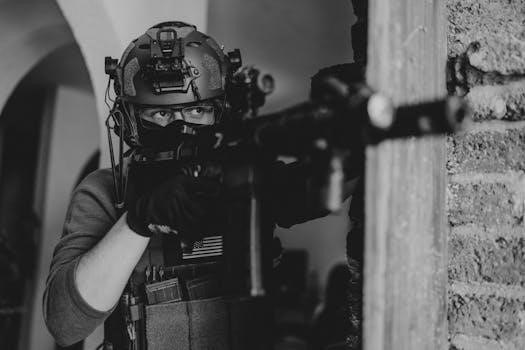Stealth Cam Operating Instructions⁚ A Comprehensive Guide
Welcome! This guide provides comprehensive Stealth Cam operating instructions. Find your model number, understand camera components, and perform initial setup. Learn basic operations, navigate menus, and utilize quick set modes. Explore advanced settings and firmware updates for optimal performance.
Finding Your Stealth Cam Model Number
Locating your Stealth Cam model number is crucial for accessing the correct manuals and firmware updates. Typically, the model number can be found on the back of the camera unit. Look for a label or sticker that contains alphanumeric characters, often near the barcode or serial number.
For current models, such as the Stealth Cam 2021 DS4K Ultimate (STC-DS4KU), the model number is clearly printed. Discontinued models like the StealthCam G45NG MAX 2 (STC-G45NG-MAX) and Stealth Cam 2020 DS4K-MAX (STC-DS4KMAX) also have easily identifiable model numbers in the same location.
If you have trouble finding it, check the original packaging or receipt. The model number is essential for downloading the correct user manual from the Stealth Cam website, ensuring you have the right instructions for your specific device.
Accessing and Downloading Manuals
To access and download Stealth Cam manuals, start by visiting the official Stealth Cam website. Navigate to the “Support” or “Downloads” section, where you can find a comprehensive list of product manuals. Alternatively, websites like ManualsLib offer a wide range of Stealth Cam manuals, categorized for easy browsing.
Once you locate your specific camera model, download the PDF manual. These manuals provide detailed instructions on camera setup, operation, and troubleshooting. For instance, the Stealth Cam QV Series User Manual and STC-BT16 Scouting Camera Manual are readily available online.
Always ensure you download the correct manual for your model to avoid confusion. Keeping your camera’s firmware up to date using the instructions found in the manual guarantees optimal performance.
Understanding Camera Components
To effectively operate your Stealth Cam, understanding its key components is essential. Typically, a Stealth Cam includes a lens for capturing images and videos, an infrared (IR) flash for night vision, and a motion sensor to detect movement. The camera body houses the electronic circuitry and battery compartment.
The control panel, usually located inside the camera, features buttons for navigating the menu and configuring settings. SD card slots allow for storing captured media, and external ports may include USB connections for transferring data. The camera’s display screen shows the current settings and allows for reviewing captured images.
Familiarizing yourself with these components ensures you can properly set up, operate, and troubleshoot your Stealth Cam for optimal performance. Refer to your user manual for specific details and diagrams.

Initial Setup and Configuration
Proper initial setup is critical for optimal Stealth Cam performance. This includes battery installation, SD card formatting, and setting the date and time. Following these steps ensures accurate data recording and efficient camera operation.
Battery Installation and Precautions
Correct battery installation is essential for reliable Stealth Cam operation. Always use high-quality batteries, following the polarity markings inside the battery compartment. Avoid mixing new and old batteries, as this can cause damage or reduce performance. Do not disassemble your camera! Ensure the batteries are properly seated to prevent power failures and data loss. For extended periods of non-use, remove the batteries to prevent corrosion. Using a solar power panel is a great way to efficiently power your camera and you won’t have to worry about replacing batteries often. Remember to always check the Stealth Cam COMMAND app for updates to maximize your experience!
SD Card Installation and Formatting
Installing and formatting the SD card correctly is crucial for storing photos and videos captured by your Stealth Cam. Locate the SD card slot, usually found inside the camera or behind a protective cover. Use Class 10 SD cards. Insert the SD card in the correct orientation until it clicks into place. Before using a new SD card, it’s recommended to format it through the camera’s menu to ensure compatibility. Formatting will erase all data on the card, so back up any important files beforehand. Properly formatted SD cards help maximize the triggered accuracy and prevent errors.
Setting Date and Time
Accurately setting the date and time on your Stealth Cam is essential for properly cataloging your captured images and videos. Incorrect date and time stamps can make it difficult to track wildlife activity or review footage effectively. Navigate to the “Settings” or “Menu” option. Use the directional buttons to adjust the year, month, day, hour, and minute. Confirm and save the settings. Some cameras offer a 24-hour time format option. Check your settings periodically, especially after replacing the batteries, as some cameras may reset to default settings. Accurate time stamps aid in analysis and record-keeping.

Basic Operation
Mastering basic operations is key to utilizing your Stealth Cam effectively. Learn how to power your camera on and off, navigate the menu system, and use quick set modes for efficient setup in the field.
Powering On/Off
To power on your Stealth Cam, locate the power switch, typically found on the bottom or side of the camera. Slide the switch to the “ON” position. A brief indicator light may illuminate, confirming the camera is active. To power off, slide the switch to the “OFF” position.
Ensure the switch clicks firmly into place to prevent accidental battery drain. Avoid disassembling your camera, as this could cause damage and void the warranty. Do not mix new and old batteries. Use only recommended battery types. Regular maintenance ensures longevity. Remove batteries during extended periods of non-use.
Always check the power switch position before deployment. Familiarize yourself with the power-saving features available. Consider utilizing a solar power panel for continuous operation in sunny conditions. Proper power management will optimize the functionality and lifespan of your device.
Remember to consult your specific model’s manual for detailed instructions, as button locations may vary.
Navigating the Menu
Accessing the menu on your Stealth Cam is essential for customizing settings. Typically, a “MENU” button initiates the process. Press this button to display the main menu options on the LCD screen. Use the directional buttons (UP, DOWN, LEFT, RIGHT) to navigate through the different menu items.
Highlight your desired setting and press the “OK” or “ENTER” button to select it. Within each setting, use the directional buttons to adjust the values or choose from available options. Once satisfied, press “OK” or “ENTER” again to save the changes.
Many cameras have a test mode you can use to check the setup. Some cameras even have a sync button.
To exit the menu, locate the “MENU” button again or a designated “EXIT” option. The camera will return to its standard operating mode. Refer to your specific model’s manual for detailed menu structures and option explanations. Practice navigating the menu to become comfortable with the various settings available.
Quick Set Modes (QSET1, QSET2, QSET3)
Stealth Cam often features Quick Set Modes (QSET1, QSET2, QSET3) for simplified operation. These modes offer pre-configured settings tailored to common scenarios. QSET1 might be optimized for general surveillance, balancing image quality and battery life. QSET2 could prioritize high-resolution images, ideal for detailed wildlife observation. QSET3 might focus on video recording, capturing motion events efficiently.
To activate a Quick Set Mode, navigate to the “Mode” or “Operation” setting within the camera’s menu. Select your desired QSET option. This will automatically apply the corresponding pre-configured settings, saving you time and effort. The settings you can change inlcude date, time and photo quality.

Quick Set Modes provide a convenient way to quickly adapt your Stealth Cam to different monitoring needs without manually adjusting individual parameters. Refer to your manual to know what each QSET does.

Advanced Features and Settings
Explore Stealth Cam’s advanced capabilities. Configure custom settings for tailored surveillance. Utilize test mode to optimize camera placement. Keep your device updated with firmware upgrades for enhanced performance. These features improve your overall camera experience.
Custom Settings Configuration
Stealth Cam offers extensive customization options. Navigate to the “Custom Settings” menu to tailor the camera to your specific needs. Configure photo resolution, video length, and trigger sensitivity. Adjust the infrared flash intensity for optimal night vision. Set time-lapse intervals for long-term monitoring.
Customize the operational period by setting start and end times. Use the “Timer” function to activate the camera only during specific hours. Adjust motion detection range to reduce false triggers. Consider setting up password protection. Explore the option of enabling GPS coordinates to track location information on your images. Review image stamp settings to include date, time, temperature, and moon phase.
Experiment with different settings to find the optimal configuration for your unique use case. Properly adjusting custom settings can significantly enhance the effectiveness and efficiency of your Stealth Cam. Save your configurations for future use.
Test Mode Functionality
The Test Mode on your Stealth Cam is a crucial feature for ensuring proper camera placement and functionality before deployment. By activating Test Mode, you can walk in front of the camera to test the detection range and trigger speed. The camera will take a photo or video, allowing you to immediately review the results.
Use Test Mode to adjust the camera’s angle and position for optimal coverage. Check the image quality to ensure clarity and focus. Verify that the date, time, and other stamp information are correctly displayed. After testing, remember to exit Test Mode to enable normal operation.
Test Mode also helps troubleshoot potential issues such as false triggers or detection blind spots. Consult your Stealth Cam manual for specific instructions on accessing and using Test Mode. Properly utilizing this function can save time and ensure your camera is set up for successful monitoring.
Firmware Updates
Keeping your Stealth Cam‘s firmware up to date is essential for optimal performance and access to the latest features. Firmware updates often include bug fixes, performance improvements, and new functionalities that enhance your camera’s capabilities. Visit the Stealth Cam website to check for available updates for your specific model.
Download the latest firmware file and follow the instructions provided in the product manual to install it on your camera. Typically, this involves transferring the firmware file to an SD card and inserting it into the camera. Then, navigate to the update option in the camera’s menu and initiate the process.
During the firmware update, ensure the camera has a stable power source and avoid interrupting the process. Once the update is complete, verify the version number to confirm successful installation. Regularly checking for and installing firmware updates will keep your Stealth Cam running smoothly.